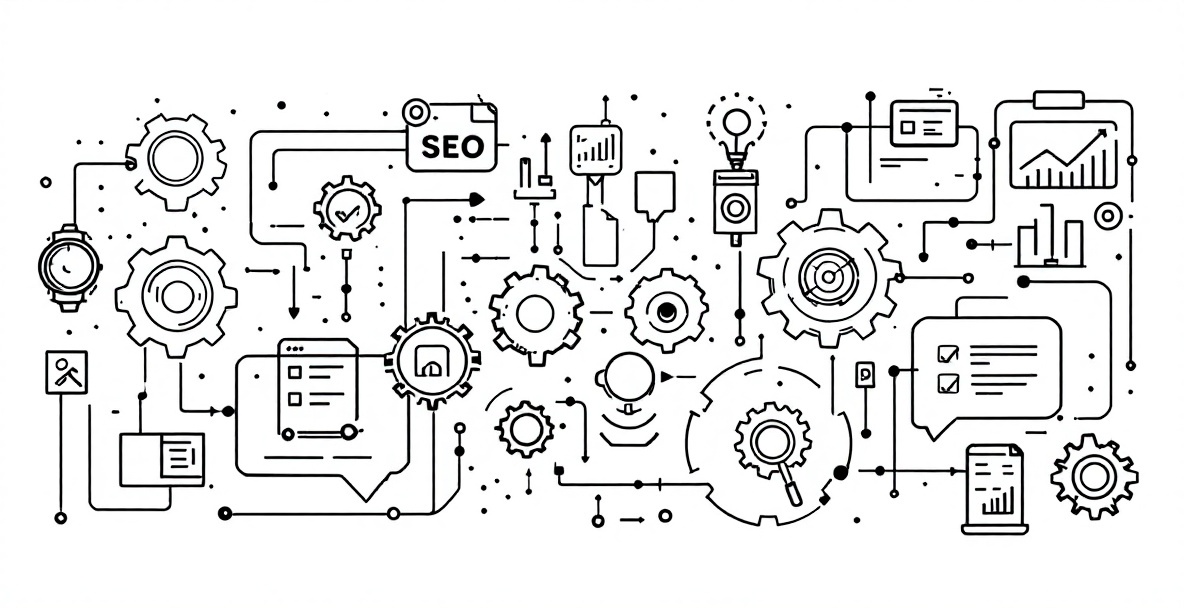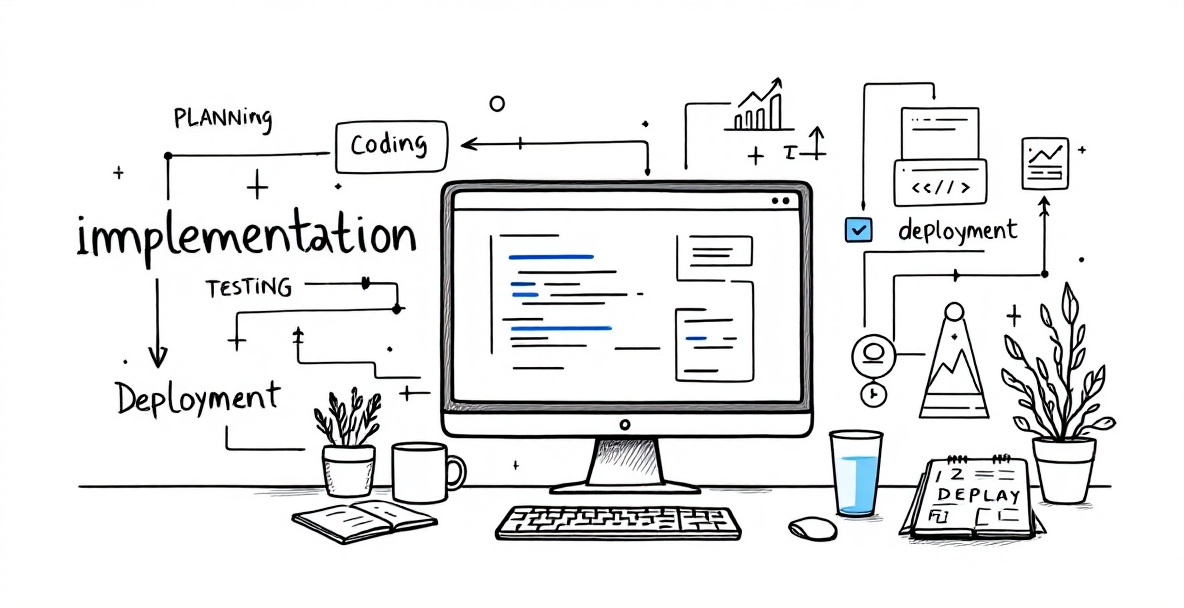In the competitive digital marketing landscape, time is perhaps your most valuable resource. Our analysis at SEO Tuts shows that marketing professionals spend up to 40% of their work hours on repetitive tasks that could be automated. By implementing the right marketing automation workflows, you can reclaim this time while simultaneously improving campaign performance and consistency. This article reveals the practical automation systems that consistently save our clients and students over 10 hours weekly.
The Growing Need for Marketing Automation in Digital Strategy

Marketing automation has evolved from a competitive advantage to an essential survival tool. As digital channels multiply and consumer expectations rise, marketing teams face increasing pressure to deliver personalized, data-driven campaigns across numerous touchpoints—often with limited resources.
Current Marketing Time Management Challenges
Digital marketers today juggle an expanding set of responsibilities. Technical SEO monitoring requires constant attention to crawl errors, site performance issues, and indexation status. Content calendars demand meticulous planning, creation, and distribution across multiple platforms. Meanwhile, analytics reporting consumes hours of time collecting, formatting, and interpreting data from disparate sources.
Our research at SEO Tuts indicates that marketing professionals spend approximately 16 hours weekly on tasks that could be partially or fully automated. These include repetitive activities like keyword rank checking, competitor monitoring, social media scheduling, and performance reporting. The cognitive load of context-switching between these varied responsibilities further diminishes productivity and creative thinking capacity.
The pressure to demonstrate ROI compounds these challenges, as marketing teams must document their impact while simultaneously executing campaigns. This documentation process alone consumes 5-7 hours weekly for the average marketing department, according to our client surveys.
The ROI of Marketing Automation
Implementing structured marketing automation delivers remarkable returns. Beyond the obvious time savings, automation creates consistency, reduces human error, and enables scaling of marketing efforts without proportional increases in headcount.
According to research we've analyzed, organizations implementing comprehensive marketing automation experience an average 14.5% increase in sales productivity and a 12.2% reduction in marketing overhead. The impact on marketing-generated revenue is even more significant, with businesses reporting 34% higher revenue contribution from marketing teams post-automation.
At SEO Tuts, we've documented that properly configured automation workflows typically achieve ROI breakeven within 4-6 months of implementation. The long-term value becomes exponential as workflows mature and teams redirect saved time toward strategic initiatives and creative development.
Essential SEO and Content Automation Workflows

SEO and content marketing present particularly rich opportunities for automation, with technical monitoring and content production workflows that can dramatically reduce manual intervention while improving consistency.
Automated Technical SEO Monitoring
Technical SEO issues can undermine even the most brilliant content strategy if left undetected. Establishing automated monitoring for these fundamental elements prevents costly problems while eliminating hours of manual checking.
Crawl error monitoring represents a prime automation opportunity. By configuring tools like Screaming Frog or Sitebulb to run scheduled crawls and send differential reports, you receive actionable alerts about new 404 errors, redirect chains, or orphaned pages without manual intervention. One of our SEO Tuts clients implemented this workflow and reduced their weekly technical maintenance time from 6 hours to just 30 minutes of focused issue resolution.
Site performance monitoring should also be automated. Tools like Google Lighthouse can be scheduled to run programmatically, sending alerts when core web vitals or mobile usability metrics fall below established thresholds. This prevents gradual site deterioration while eliminating the need for constant manual checking.
Rank tracking automation represents another major time-saver. Rather than manual searches or one-off tool checks, configure scheduled rank reports with automatic comparison to previous periods. This workflow flags significant position changes requiring attention while eliminating hours spent monitoring stable terms.
Content Planning and Creation Automation
Content creation workflows offer substantial automation potential throughout the production cycle. At SEO Tuts, we've developed systems that reduce content production time by 40% without sacrificing quality.
Automated content research tools like BuzzSumo API integrations can continuously monitor trending topics in your industry and automatically populate a research database with relevant articles, engagement metrics, and publishing patterns. This creates an always-fresh content idea repository without manual searching.
Content briefs—detailed outlines that guide writers—can be partially automated through templates and NLP analysis tools. By establishing a system that automatically analyzes top-ranking content for a target keyword and extracts structure, topics, and semantic requirements, you create comprehensive briefs in minutes rather than hours.
Editorial calendar automation represents another significant opportunity. Workflow tools can schedule content needs based on seasonal trends, business goals, and historical performance data. When integrated with team capacity planning, these systems prevent bottlenecks while ensuring consistent production without manual scheduling sessions.
Automated Performance Tracking
Performance tracking consumes enormous time when managed manually. Creating automated reporting systems eliminates this burden while providing more consistent insights.
Developing automated Google Analytics and Google Search Console dashboards with Data Studio (now Looker Studio) eliminates hours of manual data collection and formatting. Configure these dashboards to automatically refresh and distribute via email at regular intervals, replacing manual report creation entirely.
Multi-channel attribution reporting can also be automated. By establishing consistent UTM parameter conventions and automated data pipeline connections between advertising platforms and analytics tools, you create always-current attribution models without manual data reconciliation.
Competitor performance monitoring represents another automation opportunity. Tools like SEMrush APIs can be configured to track competitor content, keyword rankings, and backlink acquisition, alerting you to significant changes without constant manual checking.
E-commerce and Conversion Optimization Automation

E-commerce marketing presents unique automation opportunities focused on product optimization, conversion enhancement, and customer journey management.
Product Page Optimization Workflows
Product page performance directly impacts revenue, making automated optimization especially valuable. At SEO Tuts, we've helped e-commerce clients implement automated product page analysis workflows that continuously assess elements like:
Product title optimization can be automated through systems that analyze search trends and competitor titles, then generate recommendations for product naming conventions. These workflows identify opportunities for incorporating high-value terms without manual research for each product.
Automated product schema validation ensures rich results eligibility without constant manual checking. By implementing monitoring systems that verify proper structured data implementation across your product catalog, you prevent revenue-damaging technical issues while eliminating tedious verification processes.
Price comparison monitoring can also be automated. Systems that track competitor pricing for similar products allow dynamic adjustment of your positioning without manual market checks. This workflow enables responsive pricing strategies with minimal oversight.
Conversion Rate Automation
Conversion optimization presents rich automation possibilities that simultaneously increase revenue while reducing manual intervention.
A/B test management can be largely automated through platforms that continuously test page variations according to predefined parameters. Rather than manually creating and monitoring tests, these systems automatically allocate traffic, measure significance, and implement winners based on your criteria.
Cart abandonment recovery represents another powerful automation opportunity. Establishing triggered email sequences based on cart abandonment behavior recovers revenue without manual intervention. These workflows can include dynamic incentives based on cart value or customer history for optimal conversion.
Product recommendation engines offer perhaps the most valuable e-commerce automation. Machine learning systems that continuously analyze purchase patterns and automatically display relevant recommendations drive substantial additional revenue without marketing team effort after initial configuration.
Customer Journey Automation
Managing customer journeys across multiple touchpoints presents perfect automation opportunities that both improve experience and eliminate manual processes.
Customer segmentation and targeting can be automated through systems that continuously update customer segments based on behavior and demographics. These workflows enable precisely targeted messaging without manual list management or segment updating.
Post-purchase follow-up sequences represent high-value automation opportunities. Workflows that automatically deliver educational content, cross-sell recommendations, and review requests based on purchase behavior nurture customer relationships without manual intervention.
Loyalty program management automation eliminates significant administrative overhead. Systems that automatically track points, deliver tier-specific benefits, and prompt engagement during inactive periods maintain program effectiveness without constant manual attention.
Link Building and Authority Development Automation

Link building and authority development—crucial but time-consuming aspects of SEO—benefit tremendously from automation while maintaining necessary quality control.
Link Building Automation
Automating key aspects of link building dramatically increases efficiency while maintaining the relationship focus essential for quality results.
Prospect identification can be largely automated through systems that continuously monitor relevant sites, new content in your industry, and resource pages matching your criteria. These workflows continuously populate prospect databases without manual searching.
Outreach management systems represent essential automation tools. Platforms that manage personalized outreach sequences, track responses, and schedule follow-ups eliminate hours of manual email management while ensuring consistent communication.
Link monitoring should also be automated. Systems that track both your backlink profile and competitors' new acquisitions alert you to opportunities and threats without constant manual checking. This workflow enables responsive strategy adjustment with minimal time investment.
Authority Building Workflows
Authority development extends beyond links to broader relationships and presence. Automating these processes ensures consistent authority building with minimal oversight.
Media monitoring automation identifies unlinked brand mentions that can be converted to backlinks. By configuring tools to continuously scan for brand references without attribution, you create a steady stream of high-conversion link opportunities without manual searching.
Content syndication workflows can be largely automated through systems that repurpose and distribute content across appropriate platforms based on content type and audience. These workflows extend content reach without manual reformatting and submission.
Social proof accumulation can also be automated. Systems that collect and display customer reviews, social media mentions, and other validation signals continuously strengthen perceived authority without manual curation efforts.
Implementation and Optimization Guide
Successfully implementing marketing automation requires methodical approach and ongoing refinement to maximize time savings and performance benefits.
Getting Started with Automation
Begin your automation journey strategically by identifying high-impact opportunities through time auditing. Document where your team currently spends time, then prioritize automation projects based on potential time savings multiplied by frequency of the task.
Start with standalone workflows before attempting comprehensive integration. Implement successful automation in discrete marketing activities before connecting systems into more complex workflows. This approach builds confidence and expertise while delivering immediate time savings.
Select appropriate tools based on your specific requirements rather than adopting comprehensive platforms prematurely. At SEO Tuts, we've observed the most successful automation implementations begin with specialized tools addressing specific workflows before graduating to integrated marketing automation platforms.
Build iteratively, focusing on one workflow per week or month depending on your resources. This measured approach prevents overwhelm while ensuring proper configuration and adoption of each automated system.
Measuring and Optimizing Results
Establish clear metrics for each automated workflow, tracking both time saved and performance impact. This dual measurement ensures automation enhances results rather than merely reducing effort.
Schedule regular automation audits to identify underperforming workflows and optimization opportunities. As marketing conditions and business needs evolve, workflows require corresponding updates to maintain effectiveness.
Document all automation workflows comprehensively, creating process libraries that enable knowledge transfer and consistent implementation. This documentation prevents workflow disruption during team changes and enables continuous improvement.
Continuously explore emerging automation technologies that may offer additional efficiency or performance improvements. The automation landscape evolves rapidly, presenting new opportunities for time savings and effectiveness enhancements.
By systematically implementing these proven marketing automation workflows, you'll reclaim valuable time for strategic thinking and creative development while simultaneously improving marketing performance and consistency. The compounding benefits of well-designed automation become increasingly valuable as your marketing operation scales.
Ready to implement these time-saving marketing automation workflows in your organization? Visit SEO Tuts today for step-by-step implementation guides, automation templates, and expert coaching to help you build these systems in your specific marketing environment.
Leave a Reply